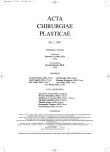BURIED UMBILICUS: AN IATROGENIC CAUSE OF A DISCHARGING UMBILICAL WOUND
Autoři:
D. Mendis 1; M. J. Pohl 2
Působiště autorů:
Department of ENT Surgery, University Hospital Coventry, Coventry, and
1; Department of Plastic Surgery, St George’s NHS Trust, London, Great Britain
2
Vyšlo v časopise:
ACTA CHIRURGIAE PLASTICAE, 49, 1, 2007, pp. 19-20
CASE REPORT
A 34-year old Brazilian lady, who had an abdominoplasty and reconstruction of umbilicus in Brazil one-year previously, was referred to the Plastics department with a diagnosis of a possible stitch abscess. The original surgery was carried out abroad and therefore no further history as to the reasons why the patient had an abdominal reconstruction was known. Previous surgical history of note consisted of bilateral breast implants and two previous caesarean sections.
The patient was admitted one year post-operatively, under the general surgeons with a diagnosis of periumbilical cellulitis with pus discharge from the reconstructed umbilicus, which was essentially a cresenteric scar. Microbiology of the pus and an abdominal ultrasound were unremarkable. A visible stitch was removed, which subsequently caused the infection to settle and the patient was then discharged home.
At the first Plastic Surgery outpatient review the patient’s main complaint was of an intermittent umbilical discharge; possibly suggesting a deeper stitch abscess. The scar was noted to be hypertrophic in the middle part and around the neo-umbilicus and this was managed with an intra-lesional steroid injection. At the next outpatient review the umbilical discharge had settled, however there was no improvement in the cosmetic appearance of the scar. To correct this a plan for further surgery with possible post-operative radiotherapy was made. After further evaluation by the radiotherapists this was deemed to be unnecessary. The patient was in agreement with this decision and was subsequently discharged from outpatient review.
After three post-operative years the patient was re-referred to the department because of a recurrence of intermittent umbilical wound discharge. The neo-umbilicus was noted to have a palpable lump, again possibly due to a retained stitch. Consequently, the patient was listed for a local anaesthetic exploration of the umbilicus and refashioning as a day case.
During the surgery the umbilicus was incised as a crescent superiorly, and a discharging cyst was found; its contents were evacuated and a wound swab was taken. Further exploration demonstrated this not to be an epidermoid cyst, or fibrosis but dermis from the original umbilicus, which had originally been left in place and buried (Fig. 1). The wound was irrigated, the skin edges trimmed and the old umbilicus was exteriorised and sutured in place. The patient has had no further problems at follow-up.

DISCUSSION
This case represents one of the possible iatrogenic causes in the differential diagnoses of periumbilical cellulitis. Other possible differential diagnoses are classified as primary and secondary umbilical disorders.
Primary conditions include infections of embryological remnants such as an infected patent omphalomesenteric duct or sinus, vitelline sinus or cyst, urachal sinus or cyst, umbilical polyp or torsion of a Meckel’s diverticulum. This group also includes stitch granuloma, pilonidal sinus disease, epidermoid and sebaceous cysts, incarcerated umbilical hernia and primary umbilical carcinoma. Secondary umbilical discharge or omphalitis is caused by suppurative intra-abdominal and pelvic pathology such as a perforated appendix and secondary carcinoma of the umbilicus and endometriosis (1, 2).
These can be clinically differentiated from each other; a true umbilical hernia is a protrusion of a viscus through the umbilicus generally presenting at birth. Pilonidal sinus disease is demonstrated by the presence of hairs deep in the umbilical skin usually protruding from a small sinus and suture granulomas can be distinguished from the history. However, in the majority of cases surgical excision or correction as in this case, provides the diagnosis and definitive treatment for symptomatic umbilical anomalies and inflammatory disorders. Other diagnostic and surveillance modalities being ultrasound used particularly for asymptomatic urachal anomalies (3), computerised tomography (CT) and sinus contrast studies.
CONCLUSION
We report on an iatrogenic cause of an infected umbilicus, which should be considered as part of the differential diagnoses. Furthermore, a definitive diagnosis and treatment is achievable with surgical intervention.
Address for correspondence:
D. Mendis
Department of ENT Surgery
University Hospital Coventry
Clifford Bridge Road
Coventry, CV2 2DX
Great Britain
E-mail: dulanimendis@yahoo.com
Zdroje
1. Goldberg R., Pritchard B., Gelbard M. Umbilical inflammatory conditions: case report and differential diagnosis. J. Emer. Med., 10, 1991, p. 151–156.
2. McClenathan JH. Umbilical epidermoid cyst: an unusual cause of umbilical symptoms. Canadian J. Surg., 45, 2002, p. 303–304.
3. Ueno T., Hashimoto H., Yokoyama H., Ito M., Kouda K., Kanamaru H. Urachal anomalies: ultrasonography and management. J. Pediatric Surg., 38, 2003, p. 1203–1207.
Štítky
Chirurgia plastická Ortopédia Popáleninová medicína TraumatológiaČlánok vyšiel v časopise
Acta chirurgiae plasticae

2007 Číslo 1
- Metamizol jako analgetikum první volby: kdy, pro koho, jak a proč?
- Fixní kombinace paracetamol/kodein nabízí synergické analgetické účinky
- Antidepresivní efekt kombinovaného analgetika tramadolu s paracetamolem
- Kombinace paracetamolu s kodeinem snižuje pooperační bolest i potřebu záchranné medikace
- Kombinace metamizol/paracetamol v léčbě pooperační bolesti u zákroků v rámci jednodenní chirurgie
Najčítanejšie v tomto čísle
- NEO-PHALLOPLASTY WITH RE-INNERVATED LATISSIMUS DORSI FREE FLAP: A FUNCTIONAL STUDY OF A NOVEL TECHNIQUE
- AN OBJECTIVE EVALUATION OF CONTRACTION POWER OF NEO-PHALLUS RECONSTRUCTED WITH FREE RE-INNERVATED LD IN FEMALE-TO-MALE TRANSSEXUALS
- A new method of skin erythrosis evaluation in digital images
- COMBINATION OF POSTERIOR INTEROSSEOUS AND HYPOGASTRIC FLAP FOR SKIN DEFECT RECONSTRUCTION IN HAND INJURIES
